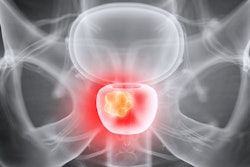
A team of international researchers has successfully tested a risk prediction model that combines clinical data and MRI parameters to improve the detection of clinically significant prostate cancer and reduce unnecessary biopsies, according to a study published online February 22 in JAMA Oncology.
The novel approach adds MRI-derived prostate volume and scores from version 2 of the Prostate Imaging Reporting and Data System (PI-RADS) to standard factors to gauge prostate cancer. When tested on a group of more than 200 patients, the model significantly reduced false positives and decreased the need for biopsy.
"This model improved risk stratification among patients with positive findings on prostate MRI and can be applied to other independent patient populations," wrote the group led by Dr. Sherif Mehralivand from University Medical Center in Mainz, Germany.
The researchers started with a baseline risk model that featured common variables such as age, ethnicity, prior negative biopsy, abnormal results from a digital rectal examination, and prostate-specific antigen (PSA) levels. They took these predictors and added MRI-derived prostate volume and PI-RADS to create the advanced risk model.
The prediction model was then tested on 251 patients at two independent institutions. All subjects underwent multiparametric MRI, MRI transrectal ultrasound (TRUS) fusion-guided biopsy, and 12-core systematic biopsy in one session.
To be enrolled in the study, patients had elevated serum PSA levels or abnormal results from a digital rectal examination and at least one confirmed lesion from multiparametric MRI. A Gleason score of 3 + 4 or higher in at least one biopsy core was used to define clinically significant prostate cancer.
Among the 400 patients in the development group, 193 (48%) had clinically significant prostate cancer. Of the 251 patients in the validation group, 96 (38%) had similar clinically significant prostate cancer.
In comparing the two approaches, using the advanced risk prediction model increased the area under the curve to 84%, compared with 64% for the baseline model (p < 0.001). Using a risk threshold of 20%, the MRI-based risk model achieved a lower false-positive rate (46%) than the baseline model (92%). There also was a small reduction in the true-positive rate with the MRI-based model (89%) versus the baseline model (99%).
In addition, the researchers found that 18 fewer biopsies could have been performed per 100 men, with no increase in the number of patients with missed clinically significant prostate cancers.



















